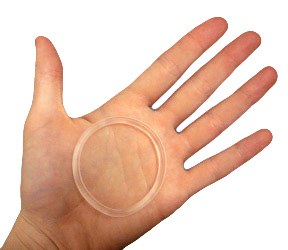Vaginal ring
Vaginal Ring[edit | edit source]
A vaginal ring is a type of hormonal contraception that is inserted into the vagina to provide birth control. It is a flexible, plastic ring that releases a continuous dose of estrogen and progestin hormones to prevent ovulation.
Mechanism of Action[edit | edit source]
The vaginal ring works primarily by preventing ovulation. The hormones released by the ring inhibit the hypothalamic-pituitary-gonadal axis, reducing the secretion of gonadotropins such as luteinizing hormone (LH) and follicle-stimulating hormone (FSH). This suppression prevents the ovaries from releasing an egg, thereby preventing fertilization.
Additionally, the hormones thicken the cervical mucus, making it more difficult for sperm to enter the uterus. They also alter the endometrium, reducing the likelihood of implantation should fertilization occur.
Usage[edit | edit source]
The vaginal ring is typically inserted into the vagina and left in place for three weeks. After three weeks, the ring is removed for a one-week break, during which the user experiences a withdrawal bleed similar to a menstrual period. A new ring is then inserted to begin the next cycle.
Insertion and Removal[edit | edit source]
To insert the ring, the user compresses it and gently pushes it into the vagina until it feels comfortable. The exact position of the ring is not critical for its effectiveness. To remove the ring, the user hooks a finger under the rim and gently pulls it out.
Advantages[edit | edit source]
- Convenience: The ring only needs to be replaced once a month, making it a convenient option for many users.
- Reversibility: Fertility typically returns quickly after discontinuation of the ring.
- Reduced Menstrual Symptoms: Many users experience lighter and less painful periods.
Disadvantages[edit | edit source]
- Side Effects: Some users may experience side effects such as nausea, headaches, or breast tenderness.
- Vaginal Discomfort: Some users may feel discomfort or irritation in the vagina.
- Hormonal Risks: As with other hormonal contraceptives, there is a small increased risk of blood clots and other cardiovascular issues.
Related Pages[edit | edit source]
Search WikiMD
Ad.Tired of being Overweight? Try W8MD's physician weight loss program.
Semaglutide (Ozempic / Wegovy and Tirzepatide (Mounjaro / Zepbound) available.
Advertise on WikiMD
|
WikiMD's Wellness Encyclopedia |
| Let Food Be Thy Medicine Medicine Thy Food - Hippocrates |
Translate this page: - East Asian
中文,
日本,
한국어,
South Asian
हिन्दी,
தமிழ்,
తెలుగు,
Urdu,
ಕನ್ನಡ,
Southeast Asian
Indonesian,
Vietnamese,
Thai,
မြန်မာဘာသာ,
বাংলা
European
español,
Deutsch,
français,
Greek,
português do Brasil,
polski,
română,
русский,
Nederlands,
norsk,
svenska,
suomi,
Italian
Middle Eastern & African
عربى,
Turkish,
Persian,
Hebrew,
Afrikaans,
isiZulu,
Kiswahili,
Other
Bulgarian,
Hungarian,
Czech,
Swedish,
മലയാളം,
मराठी,
ਪੰਜਾਬੀ,
ગુજરાતી,
Portuguese,
Ukrainian
Medical Disclaimer: WikiMD is not a substitute for professional medical advice. The information on WikiMD is provided as an information resource only, may be incorrect, outdated or misleading, and is not to be used or relied on for any diagnostic or treatment purposes. Please consult your health care provider before making any healthcare decisions or for guidance about a specific medical condition. WikiMD expressly disclaims responsibility, and shall have no liability, for any damages, loss, injury, or liability whatsoever suffered as a result of your reliance on the information contained in this site. By visiting this site you agree to the foregoing terms and conditions, which may from time to time be changed or supplemented by WikiMD. If you do not agree to the foregoing terms and conditions, you should not enter or use this site. See full disclaimer.
Credits:Most images are courtesy of Wikimedia commons, and templates, categories Wikipedia, licensed under CC BY SA or similar.
Contributors: Prab R. Tumpati, MD

